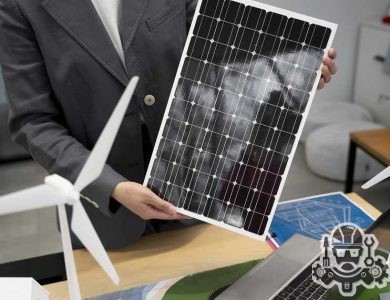Understanding The Basics Of Energy Calculations

Energy is a fundamental concept in physics. Understanding how energy works is critical to making accurate energy calculations. Energy calculations help to evaluate energy consumption, identify energy efficiency measures, and monitor energy savings. The following paragraphs will provide an overview of energy calculations and the key parameters involved in calculating energy consumption.
Energy calculations involve determining the amount of energy used in a system, process, or building. The unit of energy is typically measured in joules (J) or watt-hours (Wh). One of the critical parameters involved in energy calculations is power. Power is the rate at which energy is consumed and is measured in watts (W). To calculate energy consumption, you need to know the power consumption of the device, appliance, or system and the duration of its use. This information is typically provided on the label or specification sheet of the equipment.
| Device | Power Consumption (Watts) | Usage Time (Hours/Day) | Daily Energy Consumption (Wh) |
|---|---|---|---|
| Refrigerator | 150 | 24 | 3600 |
| TV | 50 | 4 | 200 |
| Laptop | 30 | 8 | 240 |
The table above illustrates the power consumption and daily energy consumption for a refrigerator, TV, and laptop by multiplying the power consumption by the usage time in hours per day.
Another essential parameter in energy calculations is energy efficiency. Energy efficiency is a measure of how well a device or system converts input energy (such as electricity or fuel) into useful output energy. A more energy-efficient device, appliance, or system will use less energy to perform the same function. Improving energy efficiency is a crucial strategy in reducing energy consumption and mitigating greenhouse gas emissions from energy use.
In conclusion, understanding the basics of energy calculations is essential for managing energy consumption, identifying energy-saving opportunities, and evaluating the energy efficiency of devices and systems. The key parameters involved in energy calculations include power consumption, energy efficiency, and duration of use. Accurate energy calculations are critical to reducing energy consumption and mitigating environmental impacts associated with energy use.
Contents
- 1 Determining Energy Consumption İn Residential Buildings
- 2 Calculating Energy Savings With Energy Efficient Lighting
- 3 Tracking Energy Usage İn Industrial Facilities
- 4 How To Calculate Energy Required For HVAC Systems
- 5 Evaluating The Efficiency Of Renewable Energy Sources
- 6 Energy Calculations For Solar Panel Installations
- 7 Importance Of Accurate Energy Calculations İn Green Building
- 8 Energy Calculations For Building Certification Programs
- 9 Using Energy Calculations To Reduce Environmental Impact
Determining Energy Consumption İn Residential Buildings

Determining the energy consumption in residential buildings is essential for understanding how much energy is being used and identifying ways to reduce energy consumption. It involves calculating the amount of energy required to heat and cool the house, power appliances and lighting, and provide hot water. Understanding these factors can help homeowners make informed decisions to reduce their energy usage and ultimately save money on their energy bills.
One way to determine energy consumption is by conducting an energy audit, which involves a thorough inspection of the home’s energy use. This includes analyzing insulation, windows, and doors to identify areas where energy is being wasted. An energy auditor may also use specialized equipment such as a blower door test to measure the home’s energy efficiency and identify any leaks or drafts that need to be fixed.
| Appliance Type | Wattage | Usage (hours/day) | Daily Energy Consumption (kWh) |
|---|---|---|---|
| Refrigerator | 150 | 24 | 3.6 |
| Television | 60 | 5 | 0.3 |
| Washing Machine | 500 | 1 | 0.5 |
| Electric Heater | 1500 | 4 | 6.0 |
Another way to determine energy consumption is by monitoring the usage of each appliance and electronic device in the home. By doing so, homeowners can identify which devices consume the most energy and adjust their usage accordingly. For example, turning off lights when leaving a room or washing clothes in cold water instead of hot can significantly reduce energy consumption.
Understanding the energy consumption in residential buildings is crucial for reducing energy usage, saving money, and protecting the environment. By conducting an energy audit and monitoring device usage, homeowners can make informed decisions to lower their energy consumption.
Calculating Energy Savings With Energy Efficient Lighting
If you’re trying to reduce your energy consumption, one effective way to do so is by switching to more energy-efficient lighting. With the right calculations, you can determine just how much energy you can save by using LED bulbs, smart lighting, or other efficiency upgrades. In this post, we’ll look at the process of calculating energy savings with energy-efficient lighting
The first step in this process is to gather information about your current lighting setup. This includes the type and wattage of bulbs you are currently using, as well as the total number of bulbs in each room. With this information, you can then compare it to the energy output of the new, more efficient bulbs you are considering.
| Bulb Type | Wattage | Output Lumens | Average Lifespan | Cost |
| LED | 10W | 800 | 25,000 hours | $5 |
| Smart | 8W | 650 | 10,000 hours | $15 |
| CFL | 15W | 800 | 15,000 hours | $3 |
Using this table as a guide, you can see that switching from traditional incandescent bulbs to LED bulbs can save up to 90% of energy for an equivalent amount of light output. Additionally, bulbs with average longer lifespan can provide significant savings in the long term, even if their up-front cost is higher than other options.
Once you have identified the new bulbs you want to use, you can calculate your potential energy savings. Multiply the new bulbs’ wattage by the total number of bulbs in your home to get the total energy output. Then, repeat this calculation for your current bulbs. The difference between the two is your potential energy savings.
- 10 LED bulbs at 10W each = 100W total
- 10 incandescent bulbs at 60W each = 600W total
- 600W – 100W = 500W saved by switching to LED bulbs
Finally, it’s important to remember that lighting is just one aspect of your overall energy consumption. Other upgrades, such as sealing air leaks or improving insulation, can also have a big impact. By making a variety of changes, you can reduce your home’s energy consumption and save money on your utility bills in the long run.
Tracking Energy Usage İn Industrial Facilities
Tracking energy usage in industrial facilities is crucial in achieving a more sustainable environment. By keeping track of energy usage, facilities can identify areas where energy is being wasted and take steps to reduce consumption. This not only helps the environment but also saves money in the long run, as energy costs can be a significant part of a facility’s expenses.
One way to track energy usage is by conducting regular energy audits. Energy audits can identify areas where energy is being wasted and provide solutions for how to address these issues. Implementing energy-efficient lighting systems and HVAC systems can also help reduce energy usage in industrial facilities.
| Benefits of tracking energy usage in industrial facilities |
|---|
| 1. Cost savings |
| 2. Improved sustainability |
| 3. Identifying areas for improvement |
Another way to track energy usage is by using energy monitoring systems. These systems can track energy usage in real-time and provide data on how much energy is being consumed throughout the facility. This information can be used to identify patterns and trends in energy usage and provide insight into areas where further improvements can be made.
Overall, tracking energy usage in industrial facilities is essential for achieving sustainability and reducing costs. By identifying areas where energy is being wasted and implementing energy-efficient solutions, facilities can not only reduce their carbon footprint but also improve their bottom line.
How To Calculate Energy Required For HVAC Systems
When it comes to HVAC systems, knowing how to calculate energy requirements is crucial for ensuring optimal efficiency and cost savings. HVAC, which stands for heating, ventilation, and air conditioning, is responsible for regulating temperature, humidity, and air quality in buildings. Proper energy calculations can help determine the ideal size and capacity of HVAC systems, as well as identify areas for potential energy savings.
One important factor when calculating energy requirements for HVAC systems is the building’s thermal envelope. This refers to the barriers that separate the interior and exterior environments, such as walls, windows, and doors. By knowing the building’s insulation values, or R-values, and the amount of air leakage, HVAC professionals can determine the amount of heating or cooling needed to maintain a comfortable environment.
| Type of HVAC System | Efficiency Level |
|---|---|
| Single Package | 13-18 SEER |
| Split System | 14-20 SEER |
| Geothermal Heat Pump | 20-30 SEER |
Another factor to consider when calculating energy requirements is the type and efficiency level of the HVAC system itself. HVAC systems with higher Seasonal Energy Efficiency Ratio (SEER) ratings will be more energy efficient and cost-effective in the long run. Different types of HVAC systems, such as single package, split system, or geothermal heat pumps, also have varying levels of efficiency.
Finally, it’s important to factor in the building’s occupancy and usage patterns. Buildings with high occupancy rates and frequent use of certain areas may require more heating or cooling than those with lower occupancy rates. By taking these factors into account, HVAC professionals can accurately calculate energy requirements and recommend the most efficient HVAC system for the building.
Evaluating The Efficiency Of Renewable Energy Sources
Renewable energy sources have become an increasingly popular topic in recent years as more people look for ways to reduce their carbon footprint. However, it’s important to understand the efficiency of these sources in order to determine which options are most practical and cost-effective.
One of the key measures of efficiency when it comes to renewable energy sources is the capacity factor. This refers to the amount of energy that a system can generate relative to its maximum output. For example, a wind turbine with a capacity factor of 30% can generate 30% of its maximum output over a given period of time. The higher the capacity factor, the more efficient the system.
| Type of Renewable Energy | Capacity Factor | Advantages |
|---|---|---|
| Solar | 10-25% | Abundant, sustainable, low maintenance |
| Wind | 25-50% | Low cost, easily scalable, no emissions |
| Hydroelectric | 70-90% | Reliable, long lifespan, efficient |
Other factors to consider when evaluating the efficiency of renewable energy sources include the location of the system, the cost of maintenance and operation, and the environmental impact. For example, a solar panel in a location with high levels of sunlight will be more efficient than one in a cloudy area. Similarly, a wind turbine in a location with high wind speeds will be more efficient than one in a calm area.
Overall, renewable energy sources have the potential to significantly reduce our reliance on fossil fuels and decrease our environmental impact. However, it’s important to carefully evaluate the efficiency and practicality of each option before making any decisions.
Energy Calculations For Solar Panel Installations
Solar energy is becoming more popular as a source of renewable energy. The use of solar panels has been growing in popularity as it produces clean energy that is ecologically friendly and has lower costs in the long run. However, to be able to install solar panels, it is necessary to perform energy calculations for solar panel installations.
One of the important aspects to consider is the energy requirements of the equipment that will be using the energy generated by the solar panels. This includes appliances, lighting, and HVAC systems. These energy requirements are typically measured in watts and must be determined before installation of the solar panels.
| Appliance | Power Consumption |
|---|---|
| Refrigerator | 500 watts |
| Washing Machine | 700 watts |
| Television | 200 watts |
Additionally, the location of the solar panels must be taken into account. The angle and orientation of the panels will affect the amount of sunlight that can be captured. The latitude of the location, as well as the average annual sunlight for the area, are also important considerations to ensure optimal energy production from the solar panels.
Finally, it is important to consider the safety of the installation process. Proper wiring, grounding, and protection equipment must be in place to ensure the safety of those involved in the installation process and also to ensure that the solar panels remain operational for the long term.
Energy calculations for solar panel installations are crucial to ensure optimal energy production and long-term sustainability of the solar panels. By considering the energy requirements of the equipment, location, and safety, it becomes possible to achieve maximum savings and minimize environmental impact.
Importance Of Accurate Energy Calculations İn Green Building
Green building is becoming an increasingly popular concept as a way to reduce the impact of buildings on the environment. Buildings, after all, account for a huge portion of energy consumption and carbon emissions. Accurate energy calculations are key to ensuring that green buildings perform as expected.
The first step in accurate energy calculations is to gather information on the building’s location, size, orientation, and design. This information is used to determine the expected energy usage for heating, cooling, lighting, and appliances. Factors like insulation, windows, and ventilation also play a major role in the energy efficiency of a building.
| Tip: | Use an energy modeling tool to analyze the building’s expected energy usage. This can help identify areas for improvement and provide a baseline for measuring actual energy savings. |
Accurate energy calculations are particularly important in green building programs like LEED (Leadership in Energy and Environmental Design). These programs provide certification for buildings that meet certain standards for energy efficiency and environmental impact. To achieve certification, a building must meet specific energy usage targets and demonstrate that it is using sustainable materials, reducing waste, and minimizing its impact on the surrounding environment.
- Key takeaway: Accurate energy calculations are essential for ensuring that green buildings perform as expected and meet certification standards. Use energy modeling tools to identify areas for improvement and measure actual energy savings.
Energy Calculations For Building Certification Programs
Building certifications, such as LEED or BREEAM, are becoming increasingly popular as a method for evaluating the sustainability and energy efficiency of buildings. To achieve certification, buildings must meet certain standards and criteria, including specific energy requirements. Therefore, accurate energy calculations are crucial in the certification process.
Energy audits are often performed to determine a building’s energy usage and identify areas for improvement. The results of these audits can be used to calculate the building’s energy performance and determine its eligibility for certification. Additionally, energy modeling software can be used to predict a building’s energy usage and identify opportunities for energy savings.
| Key factors in energy calculations for building certification programs: |
|---|
|
|
|
The above factors, along with others, are taken into consideration in the energy calculations for building certification programs. By analyzing and optimizing these factors, buildings can reduce their energy usage and environmental impact. Additionally, certifications can improve a building’s value and marketability in today’s green-conscious society.
Using Energy Calculations To Reduce Environmental Impact
Using Energy Calculations To Reduce Environmental Impact
Energy consumption is vital to societies around the world. However, as the population continues to grow, energy consumption has increased tremendously. This increase has led to environmental problems, such as climate change and pollution. Therefore, the primary objective is to reduce energy consumption and create energy-efficient systems by utilizing energy calculations.
One simple way to reduce energy consumption is by using renewable energy sources, such as solar, wind, and hydropower. Renewable energy sources are environmentally friendly and have a minimal impact on nature. However, using these sources effectively requires an understanding of energy calculations. For instance, before installing a solar panel, an energy calculation must be performed to estimate the energy output and determine the number of solar panels required.
| Renewable Energy Source | Advantages | Disadvantages |
|---|---|---|
| Solar | Environmentally friendly, available in abundance, low maintenance cost | High installation cost, dependent on weather conditions |
| Wind | Produces a large amount of energy, low operating cost | High installation cost, dependent on weather conditions |
| Hydro | Produces a large amount of energy, stable energy output | Environmental disruption, high installation cost |
Energy-efficient homes and buildings are other ways to reduce energy consumption. Energy calculations can determine the amount of energy consumed by a building and help identify areas that require improvement. These improvements could include installing energy-efficient lighting, appliances or updating insulation. By utilizing energy calculations to improve efficiency, it is possible to significantly reduce energy consumption in a building.
Finally, reducing energy consumption should not only be a priority for households and commercial buildings but also for large industrial facilities. These facilities require advanced energy calculations to analyze energy consumption patterns and help identify areas where energy reduction is possible. Reducing energy consumption in industrial processes could help contribute to a greener environment and reduce operating costs for businesses.
In conclusion, energy is a vital part of our daily lives, but it is essential to reduce energy consumption to minimize our environmental impact. By utilizing energy calculations to identify energy consumption patterns and inefficiencies, we can take steps towards creating a greener environment, both in our personal lives and in industrial applications.
Determining the energy consumption in residential buildings is essential for understanding how much energy is being used and identifying ways to reduce energy consumption. It involves calculating the amount of energy required to heat and cool the house, power appliances and lighting, and provide hot water.
If you're trying to reduce your energy consumption, one effective way to do so is by switching to more energy-efficient lighting. With the right calculations, you can determine just how much energy you can save by using LED bulbs, smart lighting, or other efficiency upgrades. In this post, we'll look at the process of calculating energy savings with energy-efficient lighting
Tracking energy usage in industrial facilities is crucial in achieving a more sustainable environment. By keeping track of energy usage, facilities can identify areas where energy is being wasted and take steps to reduce consumption. This not only helps the environment but also saves money in the long run, as energy costs can be a significant part of a facility's expenses.
When it comes to HVAC systems, knowing how to calculate energy requirements is crucial for ensuring optimal efficiency and cost savings. HVAC, which stands for heating, ventilation, and air conditioning, is responsible for regulating temperature, humidity, and air quality in buildings. Proper energy calculations can help determine the ideal size and capacity of HVAC systems, as well as identify areas for potential energy savings.
Renewable energy sources have become an increasingly popular topic in recent years as more people look for ways to reduce their carbon footprint. However, it's important to understand the efficiency of these sources in order to determine which options are most practical and cost-effective.
Solar energy is becoming more popular as a source of renewable energy. The use of solar panels has been growing in popularity as it produces clean energy that is ecologically friendly and has lower costs in the long run. However, to be able to install solar panels, it is necessary to perform energy calculations for solar panel installations.



